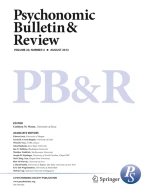518Accesses
Abstract
It has been well established for several decades that semantic organization of study materials greatly enhances recall by facilitating access to information during retrieval. However, the effect of organization on recognition, and its relationship to the effect on recall, is in doubt. We report the first direct comparison of the effects of categorically organizing study lists on recognition, cued recall, and free recall. We found that whereas organization improved recall, it impaired recognition. Organization had a larger effect on free recall than on cued recall. Within the categorized lists, recall was superior for items highly associated with the category; the opposite was true of recognition. In recall, organization improved the proportion of categories recalled, but it lowered the proportion of items per category recalled. A simple framework for interpreting the dissociation is offered. Possible mechanisms underlying the detrimental effect of organization on memory and prospects for future research are briefly discussed.
This is a preview of subscription content,log in via an institution to check access.
Access this article
Subscribe and save
- Get 10 units per month
- Download Article/Chapter or eBook
- 1 Unit = 1 Article or 1 Chapter
- Cancel anytime
Buy Now
Price includes VAT (Japan)
Instant access to the full article PDF.
References
Brainerd, C. J., &Reyna, V. F. (2002). Fuzzy-trace theory and false memory.Current Directions in Psychological Science,11, 164–169.
Brown, J. (1976). An analysis of recognition and recall and of problems in their comparison. In J. Brown (Ed.),Recall and recognition (pp. 1–35). London: Wiley.
Bruce, D., &Fagan, R. L. (1970). More on the recognition and free recall of organized lists.Journal of Experimental Psychology,85, 153–154.
Cofer, C. N., Bruce, D. R., &Reicher, G. M. (1966). Clustering in free recall as a function of certain methodological variations.Journal of Experimental Psychology,71, 858–866.
Cohen, B. H. (1963). An investigation of recoding in free recall.Journal of Experimental Psychology,65, 368–376.
Connor, J. M. (1977). Effects of organization and expectancy on recall and recognition.Memory & Cognition,5, 315–318.
Criss, A. H., &Shiffrin, R. M. (2004). Context noise and item noise jointly determine recognition memory: A comment on Dennis and Humphreys (2001).Psychological Review,111, 800–807.
D’Agostino, P. R. (1969). The blocked-random effect in recall and recognition.Journal of Verbal Learning & Verbal Behavior,8, 815–820.
Dewhurst, S. A. (2001). Category repetition and false recognition: Effects of instance frequency and category size.Journal of Memory & Language,44, 153–167.
Hintzman, D. L. (1988). Judgments of frequency and recognition memory in a multiple-trace memory model.Psychological Review,95, 528–551.
Hunt, R. R. (1995). The subtlety of distinctiveness: What von Restorff really did.Psychonomic Bulletin & Review,2, 105–112.
Jacoby, L. L. (1972). Effects of organization on recognition memory.Journal of Experimental Psychology,92, 325–331.
Kintsch, W. (1968). Recognition and free recall of organized lists.Journal of Experimental Psychology,78, 481–487.
Koutstaal, W., &Schacter, D. L. (1997). Gist-based false recognition of pictures in older and younger adults.Journal of Memory & Language,37, 555–583.
Loftus, G. R. (1978). On interpretation of interactions.Memory & Cognition,6, 312–319.
Macmillan, N. A., &Creelman, C. D. (1991).Detection theory: A user’s guide. New York: Cambridge University Press.
Mandler, G. (1972). Organization and recognition. In E. Tulving & W. Donaldson (Eds.),Organization of memory (pp. 139–166). New York: Academic Press.
Neely, J. H., &Balota, D. A. (1981). Test-expectancy and semanticorganization effects in recall and recognition.Memory & Cognition,9, 283–300.
Shiffrin, R. M., Huber, D. E., &Marinelli, K. (1995). Effects of category length and strength on familiarity in recognition.Journal of Experimental Psychology: Learning, Memory, & Cognition,21, 267–287.
Tulving, E., &Kroll, N. (1995). Novelty assessment in the brain and long-term memory encoding.Psychonomic Bulletin & Review,2, 387–390.
Tulving, E., &Pearlstone, Z. (1966). Availability versus accessibility of information in memory for words.Journal of Verbal Learning & Verbal Behavior,5, 381–391.
Van Overschelde, J. P., Rawson, K. A., &Dunlosky, J. (2004). Category norms: An updated and expanded version of the Battig and Montague (1969) norms.Journal of Memory & Language,50, 289–335.
Yonelinas, A. P. (2002). The nature of recollection and familiarity: A review of 30 years of research.Journal of Memory & Language,46, 441–517.
Author information
Authors and Affiliations
Department of Psychology, University of California, 93106-9660, Santa Barbara, CA
Scott A. Guerin & Michael B. Miller
- Scott A. Guerin
You can also search for this author inPubMed Google Scholar
- Michael B. Miller
You can also search for this author inPubMed Google Scholar
Corresponding author
Correspondence toScott A. Guerin.
Rights and permissions
About this article
Cite this article
Guerin, S.A., Miller, M.B. Semantic organization of study materials has opposite effects on recognition and recall.Psychonomic Bulletin & Review15, 302–308 (2008). https://doi.org/10.3758/PBR.15.2.302
Received:
Accepted:
Published:
Issue Date:
Share this article
Anyone you share the following link with will be able to read this content:
Sorry, a shareable link is not currently available for this article.
Provided by the Springer Nature SharedIt content-sharing initiative
